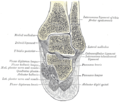Tarsal tunnel
| Tarsal tunnel | |
|---|---|
 The mucous sheaths of the tendons around the ankle. Medial aspect. | |
| Details | |
| Identifiers | |
| Latin | Canalis tarsi |
| Anatomical terminology | |
The tarsal tunnel is found along the inner leg behind the medial malleolus.
The tarsal tunnel is made up of bone on the inside and the flexor retinaculum on the outside.
Nerve distribution
The tibial nerve, posterior tibial artery, veins, and tendons travel in a bundle along this pathway, through the tarsal tunnel.
In the tunnel, the nerve splits into three different paths. One nerve (calcaneal) continues to the heel, the other two (medial plantar nerve and lateral plantar nerve) continue on to the bottom of the foot.
Tarsal tunnel syndrome is the most commonly reported nerve entrapment of the ankle and is analogous to the carpal tunnel of the wrist. People with tarsal tunnel syndrome have pain in the plantar aspect of the foot mostly at night. Weight bearing increases pain and weakness is found on intrinsic foot muscles with positive Tinel sign at the tunnel. There is no tenderness present on the plantar foot, though this is typically the primary site of complaint.
Contents of tunnel
- Tibialis posterior tendon
- Flexor digitorum longus tendon
- Posterior tibial artery
- Posterior tibial vein
- Tibial nerve
- Flexor hallucis longus tendon
Mnemonic
One common mnemonic used to remember the contents from anterior to posterior is "Tom, Dick and Harry".[1][2][3] or alternatively "Tom, Dick (and very nervous) Harry" if the artery, vein, and nerve are included.
Another common mnemonic used is "Tiny Dogs Are Not Hunters". Bear in mind that tibial veins are located on both sides of tibial artery. A further memory aid, used extensively at St George's Hospital Medical School in London, is Tom Drives A Very Nervous Horse.
A very similar mneomic taught at some Medical Schools is Another common mnemonic used is "Tom Dick And Very Naughty Harry" or alternative "Tom Dick And Very Nervous Harry".
Additional images
-
Coronal section through right talocrural and talocalcaneal joints.
-
Muscles of the back of the leg. Deep layer.
-
The popliteal, posterior tibial, and peroneal arteries.
-
Nerves of the right lower extremity Posterior view.
-
Muscles of the sole of the foot. Second layer.
-
The plantar arteries. Deep view.
-
The plantar nerves.



